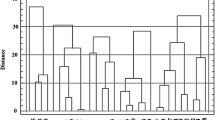Abstract
Lemna paucicostata in Japan is classified into 4 types, N-1, N-2, K and S types. S type strains which are distributed in southern Japan grew more rapidly than other strains at the temperatures of both 27 and 17C. With the extension of the culture period at 17 C to which the plants had been transferred from 25C, the growth rate increased greatly in S type strains, while it decreased in N-1 type strains which are distributed widely from Hokkaido to Kyushu, and particularly in those distributed in the northern area. S type strains survived winter mostly in the form of normal fronds under natural conditions at Kyoto (minimum temperature is lower than OC), while most of the fronds of N-1 type strains died after producing seed before winter. Thus S type strains are considered to have adapted to the climate of southern Japan so as to survive winter in the form of fronds, while N-1 type strains overwinter in the form of seed. N-2 type strains which are distributed in the northern part of the area adjacent to the Japan Sea produced turion-like fronds during winter under natural conditions, while none of the other strains did. The K type strain which was found only at the campus of Kyoto University overwintered only in the form of fronds which produce no seed.
Similar content being viewed by others
References
Beppu, T. andA. Takimoto 1981a. Geographical distribution and cytological variation ofLemna paucicostata Hegelm in Japan. Bot. Mag. Tokyo94: 11–20.
—— 1981b. Further studies on the flowering ofLemna paucicostata in Japan. Bot. Mag. Tokyo94: 69–76.
Hillman, W.S. 1961. Experimental control of flowering inLemna. IV. A relationship between medium composition and the opposite photoperiodic responses ofL. perpusilla 6746 andL. gibba G3. Amer. J. Bot.48: 413–419.
Hutner, S.H. 1953. Comparative physiology of heterotrophic growth in higher plants.In: W.E. Loomis, ed., Growth and differentiation in plant. p. 417–447. Iowa State College Press, Ames.
Landolt, E. 1957. Physiologische und ökologische Untersuchungen an Lemnaceen. Ber. Schweiz. Bot. Ges.67: 271–410.
McMillan, G. 1959. The role of ecotypic variation in the distribution of the central grassland of North America. Ecol. Monogr.29: 285–308.
— 1965. Grassland community fractions from Central North America under simulated climates. Amer. J. Bot.52: 109–116.
McNaughton, S.J. 1966. Ecotype function in theTypha community-type. Ecol. Monogr.36: 297–325.
— 1969. Genetic and environmental control of glycolic acid oxidase activity in ecotypic populations ofTypha latifolia. Amer. J. Bot.56: 37–41.
Salisbury, F.B. 1963. The flowering process. Pergamon Press, Oxford.
Yukawa, I. andA. Takimoto. 1976. Flowering response ofLemna paucicostata in Japan. Bot. Mag. Tokyo89: 241–250.
Author information
Authors and Affiliations
Rights and permissions
About this article
Cite this article
Beppu, T., Takimoto, A. Growth of various ecotypes ofLemna paucicostata in Japan under various temperature conditions, and their wintering forms. Bot. Mag. Tokyo 94, 107–114 (1981). https://doi.org/10.1007/BF02488269
Received:
Issue Date:
DOI: https://doi.org/10.1007/BF02488269




